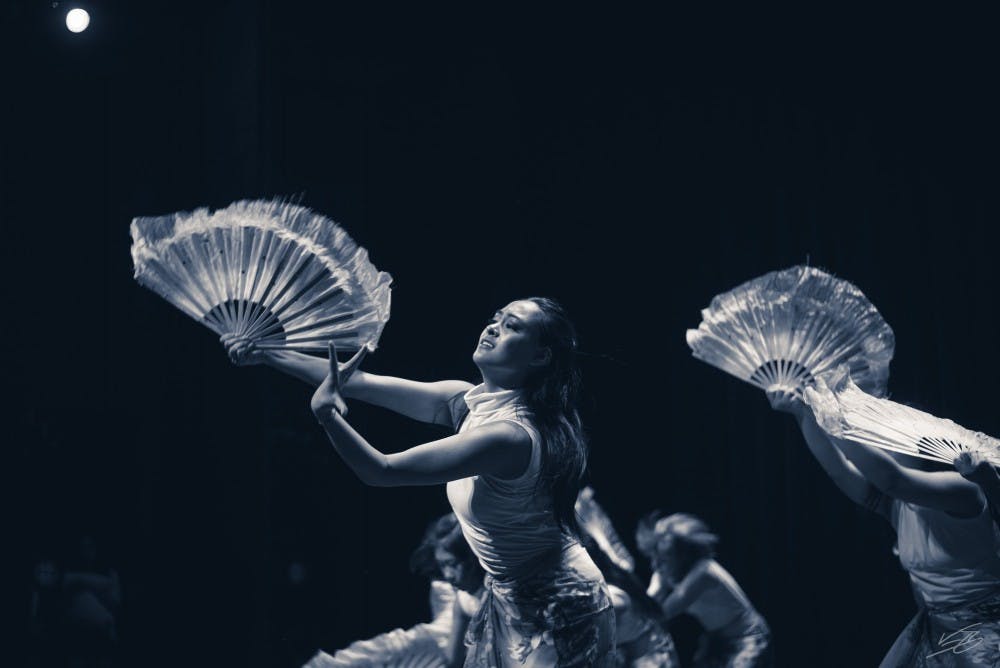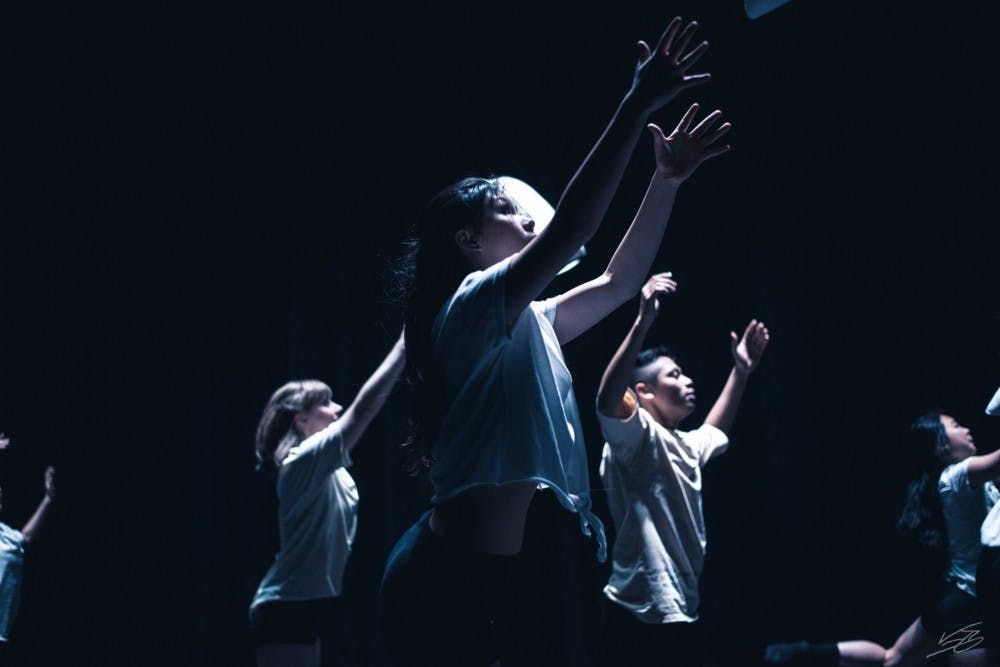I remember once walking into Whitman College. I greeted the staff member on swipe duty and asked him why he looked so cheery, to which he replied, “Your face is like a big beautiful moon in the sky.” Despite the innocuous nature of this statement, I cringed inwardly. Was my face really that chubby, circular, pale?
When I first saw the Triple 8 “Moonlit” publicity posters hanging on lampposts, I gasped in soft shock. This was how the moon should be invoked — cast dramatically across East Asian faces to play on the depths of our features and reflect off our dark, dark hair — and I was proud that photographer Vincent Po ’18 knew how to photograph East Asians to look fierce. I walked into the Triple 8 show with great excitement and wonder.
The show began with a piece by Kathryn Wen ’20 and Melita Piercy ’20 spotlighting women in bold blue t-shirt dresses and men in blue shirts of the same hue and white pants. I did not realize I would react to the piece so viscerally (this was not my first time at a dance show), yet I fought to hold back tears as I witnessed East Asian bodies being glorified on stage. To be clear, there were East Asian and non-East Asian bodies alike, but I saw bodies like my own — Asian women with big thighs and imperfect flexibility — hovering in the spotlight, elevated by movements. People cheered from the crowd, screaming, in all their pride, ethnic names.
The piece ended, the mood shifted, and I swallowed the happy lump in my throat. Chinese battle music flooded the stage. Dancers walked onstage with long, floor-length white sleeves and I remembered how a friend of mine, Jessica Fan ’20, had captioned her “Moonlit” profile picture: “Come watch me play ... with giant sleeves.” I had not known what she meant, and now I was discovering a kind of dance in which the focus homed in on the effect of the whole. Sleeves shot in unison to the left, to the right, and up in the air to create the effect of a silk-sleeved octopus and then flowed in staggered, elegant waves. Flailing pieces of cloth became startling and theatrical. It recalled an ancient tradition that went beyond my time. Yet it echoed of values I saw carried out in Asian culture contemporarily: a focus on the unity of the group, an attention to the overall effect, and a melding of individual talent to contribute to the collective presentation.

I did not understand the concept of diaspora until I came to this show. I did not think much of the importance of dedicating a dance group to the celebration of East Asian cultural dance and East Asian dancers — I thought it the product of those who cared more about preserving their own culture than I did. But now I felt deeply stirred, not only by the sacredness of a space in which East Asian people were unashamedly the focus of the event, but by the very reality that an individual cannot tear her identity away from herself, no matter how hard she tries to hide it away. The exclamations like “[insert Asian name here] you’re beautiful!” were, to me, public affirmations not only of the individual’s beauty, but of the salience of the individual’s Asianness. In my everyday life when I am not in this diasporic space, I experience what Dora Zhao ’21 tells of in her article, “What a letter can mean.” I omit my last name completely when introducing myself, signing documents, or performing any task where I identify myself. I have grown accustomed to putting away my Asian self in public whenever I can — if not my face, at least the foreign sound of who I am.

I have spent my whole life avoiding myself, and here this self was being celebrated, poured out, on stage. The theme “Moonlit” suited the show well. The variety and precision of lighting design and operation (Nathan Yoo ’18 and Ivy Xue ’20) shocked the audience; people oohed and ahhed at the lighting throughout the show. I remember a particular moment at the end of a number called “Pillows” when a soft yellow light descended over everyone as they lay down to sleep and just before the song ended, a red light shot out from the right like the last burst of a sunset before the fiery sun descends behind earth. The attention and thought shown through. The unity of costumes within each piece — from velvety hoodie crops to skin-hugging red tops — and the diversity of costumes over the course of the show reminded me of the moon changing faces as it waxes and wanes.
The superior quality of every aspect of the show reminded me that where I had failed, others had taken up the mantle. Here, Triple 8 reinforced the sanctity of an East Asian space. Here, we embraced the many facets of the individual, not leaving behind for a moment the Asian self. For this, I (especially) am eternally grateful.









